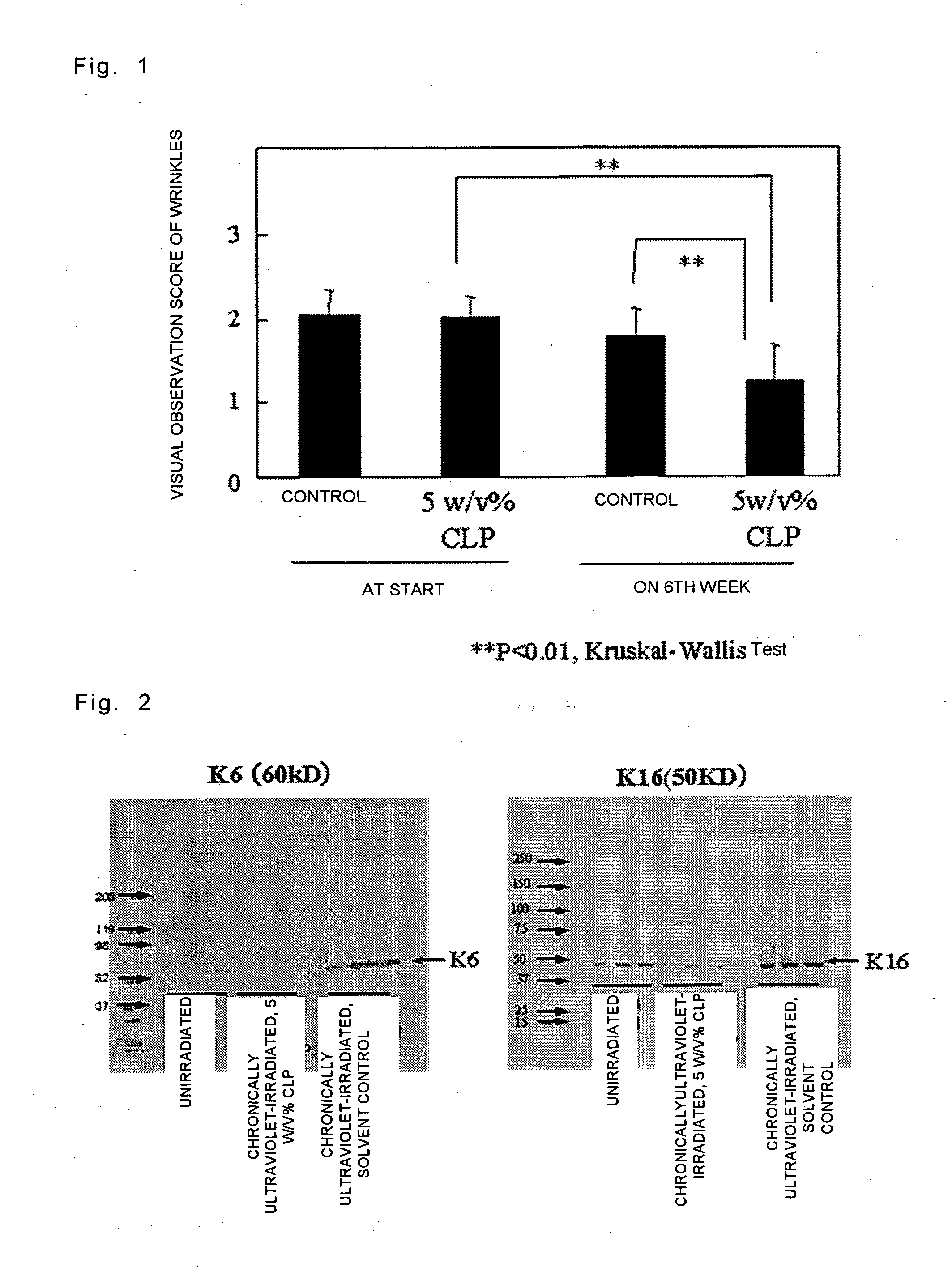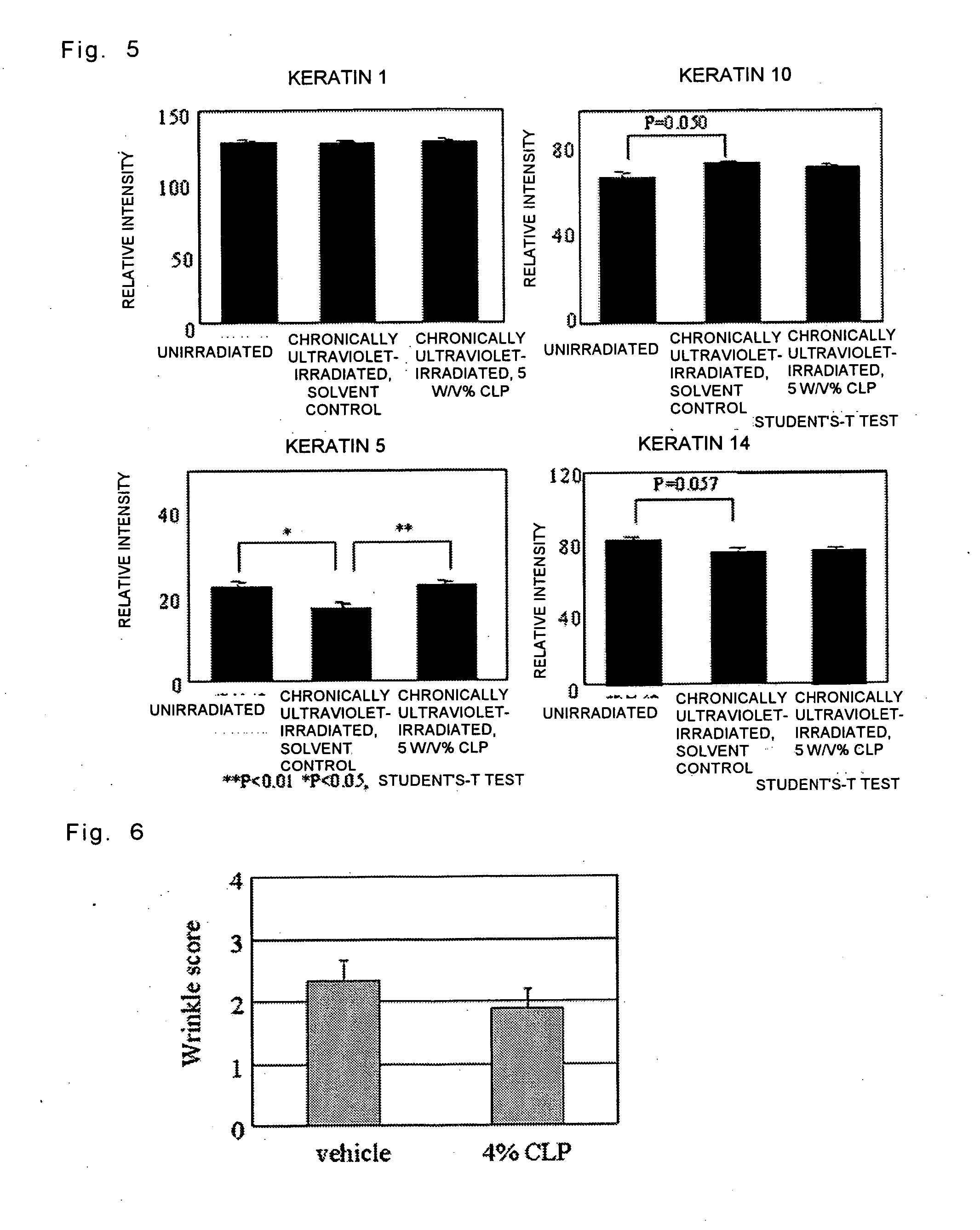Method for screening an agent for preventing or ameliorating wrinkles
a technology of wrinkle prevention and improving agent, applied in the field of screening method of photoagingor wrinkle prevention or improving agent, can solve the problem that the relationship between skin photoaging or wrinkle formation and keratin protein has not been clearly defined
- Summary
- Abstract
- Description
- Claims
- Application Information
AI Technical Summary
Benefits of technology
Problems solved by technology
Method used
Image
Examples
reference example 1
Wrinkle-Improving Effect of CLP
[0059] An experimental system of the chronic and continuous exposure of hairless mice to ultraviolet rays of minimum erythema dose (hereinafter, referred to as 1 MED) or lower (J. Pharm. Pharmacol. 1992; 44: 379-386; and Photochem. Photobiol., 1991; 53: 109-112) was used as a wrinkle formation model to perform a test of wrinkle improvement of 1-carbamimidoyl-L-proline (CLP) in vivo.
[0060] The mice used were hairless mice (Hr-1-ICR) produced from crossing between Hr-1 (Skh-1) hairless mice and ICR mice. Toshiba SE20 lamps were used as an ultraviolet source, and ultraviolet doses used were measured with UV-RADIOMETER (UVR-305 / 365D, Eisai). The 6- to 10-week-old hairless mice were exposed once a day and five times a week for 12 consecutive weeks to ultraviolet rays of 1 MED or lower, that is, at a dose of 470 J / m2 during the 0th (at the start of irradiation) to first week, at a dose of 530 J / m2 during the first to second week, at a dose of 600 J / m2 duri...
example 1
Test of Inhibition of Epidermal K6 and K16 Protein Production in Hairless Mice
[0067] Six-week-old hairless mice of the same species as in Reference Example 1 were exposed for 9 consecutive weeks to ultraviolet rays at a dose of 470 J / m2 during the 0th (at the start of irradiation) to first week, at a dose of 530 J / m2 during the first to second week, at a dose of 600 J / m2 during the second to third week, and at a dose of 670 J / m2 during the fourth and subsequent weeks, to prepare chronically ultraviolet-irradiated mice (wrinkle model mice). Then, 100 μL of 5 w / v % CLP solution (50 vol % ethanol solution) was applied once a week and five times a week for 6 consecutive weeks to the whole dorsal skin of each of the mice to examine changes in epidermal keratin protein levels. For controls, 50 vol % ethanol solution (solvent control) and unirradiated age-matched mice (unirradiated mice) were used. Each of the groups comprised 3 mice.
Quantification of Keratin Proteins by Western Blottin...
example 2
Test of Inhibitory Effect of CLP on Wrinkle Formation and Analysis of Epidermal Keratin Levels
[0073] The same 6- to 8-week-old hairless mice as in Reference Example 1 were used and exposed to ultraviolet rays of 1 MED (minimum erythema dose) or lower. Immediately after the ultraviolet irradiation, procedures for applying 100 μL of 4% (Wt / Vol %) CLP solution (solvent: 30 Vol / Vol % ethanol / water solution) or vehicle control to the whole dorsal skin of each of the mice were performed once a day and five times a week for 12 consecutive weeks. The irradiation dose was 470 J / m2 during the 0th (at the start of irradiation) to first week, 530 J / m2 during the first to second week, 600 J / m2 during the second to third week, and 670 J / m2 during the fourth and subsequent weeks. Each of the groups comprised 10 to 12 mice.
[0074] The degree of wrinkles formed on the dorsal skins of the mice was determined after 12 weeks from the start of ultraviolet irradiation according to the visual observation...
PUM
 Login to View More
Login to View More Abstract
Description
Claims
Application Information
 Login to View More
Login to View More - R&D
- Intellectual Property
- Life Sciences
- Materials
- Tech Scout
- Unparalleled Data Quality
- Higher Quality Content
- 60% Fewer Hallucinations
Browse by: Latest US Patents, China's latest patents, Technical Efficacy Thesaurus, Application Domain, Technology Topic, Popular Technical Reports.
© 2025 PatSnap. All rights reserved.Legal|Privacy policy|Modern Slavery Act Transparency Statement|Sitemap|About US| Contact US: help@patsnap.com



